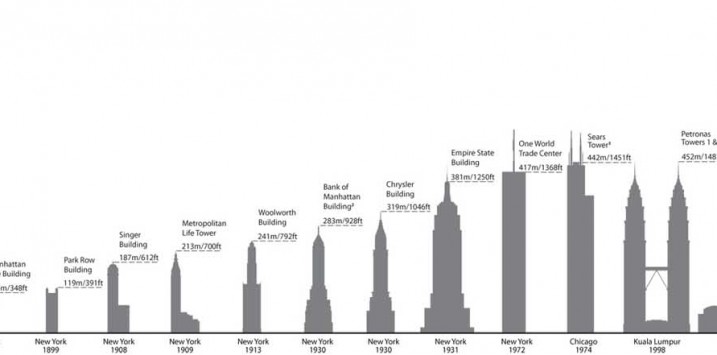
Bubble Watch #18 Tallest Buildings warns of impending stock market crash?
There are all sorts of coincidences that can be mistaken for signs that a crash is imminent. We don’t put much store in those, however it is never uninteresting reading about them. One that is gaining a little traction is something known as the Edifice Complex.
In conventional terms, the Edifice Complex is the desire to build lasting edifices or buildings as a legacy to one’s greatness. In today’s context, the Edifice Complex represents the historically coincident construction/completion of these buildings with stock market crashes.
1906: The Singer Tower at Liberty Street and Broadway in Manhattan, was a 47-story office building and the world’s tallest when construction began for a 1908 completion. In 1907 the great bull market, that began in 1895, ended with a 60 per cent crash in stocks. History tells us that major industrialist would have been wiped out if not for the liquidity provided by JP Morgan and JD Rockefeller.
1929: Three world record office buildings began construction that fateful year. There was 40 Wall Street whose construction began in May and completed in less than a year. It was beaten by the Chrysler Building, which was completed in 1930. The Chrysler building was then bested by The Empire State Building whose construction began on October 1, 1929 and was completed in 1931.
The Wall Street Crash of 1929, also known as Black Tuesday, began in late October 1929 and was the most devastating stock market crash in America’s history. The crash also signaled the beginning of the decade-long Great Depression that affected all Western industrialised countries.
1973: In 1968 construction began on The World Trade Centre in New York. It was completed in 1973, coinciding with the bear market of 1973-1974. The 1973–1974 bear market began in January 1973 and ended December 1974. All the main stock indexes of the future G7 bottomed out between September and December 1974, having lost at least 34% of their value in nominal terms, and 43% in real terms.
It has variously been described as one of the worst stock market downturns in modern history and it followed the collapse of the Bretton Woods system over the previous two years, the ‘Nixon Shock’ and the United States dollar devaluation under the Smithsonian Agreement.
1997: I was in Malaysia in the mid 90’s marveling at the skyline filled with cranes and at stories about former school yard rivals who were simply building higher towers to beat their former rivals. The Petronas Towers in Kuala Lumpur were completed in 1997.
The Asian currency/financial crisis began in July that year when Thai Baht collapsed after the government was forced to float it due to lack of foreign currency to support its peg to the U.S. dollar. The foreign currency reserves ran out following financial overextension that was in no small part due to real estate.
At the end of the last century Donald Trump began construction of the world’s tallest residential tower. The Trump World Tower was completed in April 2001, and of course during the period of construction, the world experienced the Tech Wreck.
A decade ago construction began on the 160-storey, 828 meter Burj Khalifa in Dubai. The exterior construction was completed in October 2009. In late 2009 Dubai World, the government-controlled investment firm, announced it could no longer repay its debts, threatening to bring down the entire economy. The emirate was bailed out by Abu Dhabi, an oil-rich fellow-member of the United Arab Emirates (UAE), and the UAE’s central bank.
Today: According to it’s website, 432 Park Avenue in New York will at 1,396 feet, be “The tallest residential tower in the western hemisphere” upon its completion in 2015. Shortly afterwards, 225 West 57th Street will reach 1,479 feet above street level. And by 2020 the Kingdom Tower in Jeddah will be over 1000 meters (3,280 ft) tall upon completion.
Of course for there to be significant explanatory power in tall buildings, there would be crashes each time the world record was broken. Nothing happened, for example, when Q1 on the Gold Coast became the world’s tallest residential tower in 2005.
It is probably also true that if we turn back from the start of every bull market, we will have a found a new taller building just completed, such is the frequency of skyscraper construction. This is why we have referred to the instances of occurrence as coincidences.
The question is whether the completion of the world’s tallest buildings today coincide with some far less salubrious…
Robert Summers
:
I would think that the phenomenon would have similar underlying drives as the mega-IPO and M&A cycles, or any other economically ‘marginal’ investment proposition. Substantial quantities of capital are required, largely in the form of “other people’s money”. This requires:
– Confidence in current and future conditions of the project/company/economy to be sufficiently high. Some would say overconfidence would be a neccessary precondition.
– Returns from more traditional investment opportunities to be close to exhaustion.
– Credit markets need to be sufficiently loose, and the yield spread between quality and junk issues compressed.
-There needs to be the expectation of substantial capital gains at some point in the future.
All conditions one would likely see at the more mature phase of a bull market. Credit markets are more likely to be the source of capital for Edifices, so I would think new record buildings would be a better predictor of conditions in the credit market than of the stock market (although the two are linked).
Roger Montgomery
:
That’s it: “economically ‘marginal’ investment propositions”
Roger Montgomery
:
Conversely Andrew, betting on a rational response is not always a profitable bet.